The OMNISEC system from Malvern Panalytical is a sophisticated multi-detector GPC system, which integrates intrinsic viscosity (IV), ultraviolet (UV), refractive index (RI) and light scattering detectors in order to produce a large amount of data about a sample concurrently.
The physical characteristics and behavior of polymers rely on the characteristics of the polymer molecules themselves. Molecular structure, size, molecular weight and molecular weight distribution influence how the material will behave. By controlling and understanding these properties, polymer producers can control the production and quality of polymers.
Gel-Permeation/Size-Exclusion Chromatography
Gel-permeation or size-exclusion chromatography (GPC/SEC) is generally to evaluate these parameters. In GPC, the sample is separated as it travels via a porous yet inert column matrix.
Though smaller molecules are able to enter the pores more deeply, larger molecules are excluded and hence travel via the column more quickly. The outcome is a separation based on hydrodynamic volume. In majority of cases, however, there is a need to identify the sample’s molecular weight.
This article shows how the size of common polymers, molecular weight and also the molecular weight distribution are determined by means of the OMNISEC system (Figure 1).
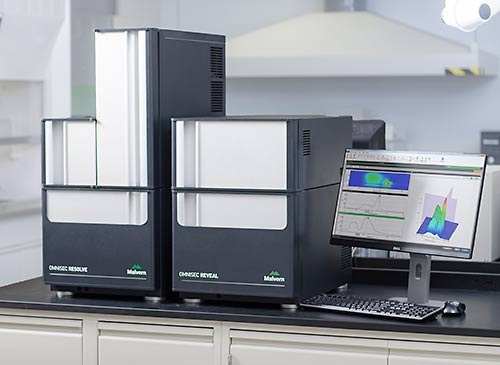
Figure 1. The OMNISEC system.
Materials and Methods
The OMNISEC system was set up in the following way. Firstly, samples were first isolated by means of two Viscotek T6000M columns. THF was the mobile phase which was stabilized with 300 ppm BHT. In order to ensure complete dissolution, the samples were made to dissolve overnight. Both the detectors and columns were maintained at 35°C in order to ensure a good separation and improve baseline stability.
The three samples studied here are a wide distribution polymethylmethacrylate (PMMA), a wide distribution polystyrene sample, and a polyvinylchloride (PVC). All three samples were then dissolved in the mobile phase and run via the system. Using the OMNISEC system, the molecular weights of these samples were determined.
Results
Figure 2A shows a chromatogram of the polystyrene sample with high polydispersity. Table 1 illustrates the quantified molecular weight, which measured by the light scattering detector showed to be 249.7 kDa.
Figure 2C shows the RI chromatogram superimposed with the molecular weight distribution, and Figure 2D depicts an overlay of the molecular weight distribution of two replicate injections for the polystyrene sample showing superior reproducibility of the light scattering data.
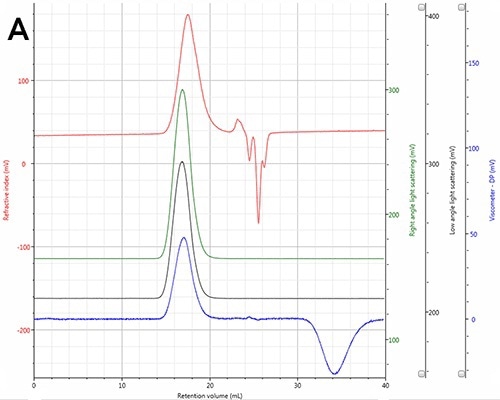
(A)
| Parameter |
Polystyrene |
| Mn (Da) |
108,900 |
| Mw (Da) |
249,770 |
| PD (Mw/Mn) |
2.294 |
| Intrinsic viscosity (dL/g) |
0.814 |
| Rhw (nm) |
13.902 |
(B)
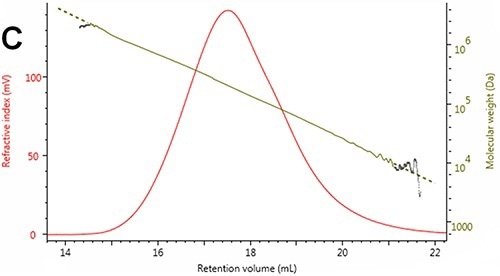
(C)
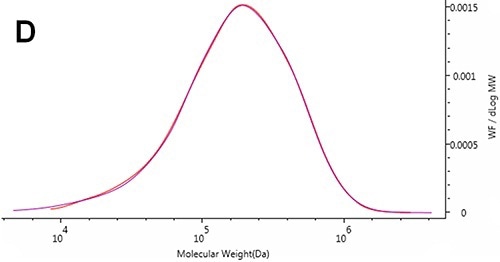
(D)
Figure 2. A. Chromatogram of the polystyrene sample showing the RI (red), Viscometer (blue) RALS (green) and LALS (black) detector signals; B. Measured molecular weight, polydispersity and intrinsic viscosity; C. RI chromatogram of the polystyrene sample overlaid with the molecular weight distribution (black); and D. Overlaid replicate injections of molecular weight distribution.
A PMMA sample was dissolved in the mobile phase and isolated on the system. Its chromatogram is shown in Figure 3A, and the molecular weight results are illustrated in Table 1. The OMNISEC system has determined the absolute molecular weight to be 89.4kDa.
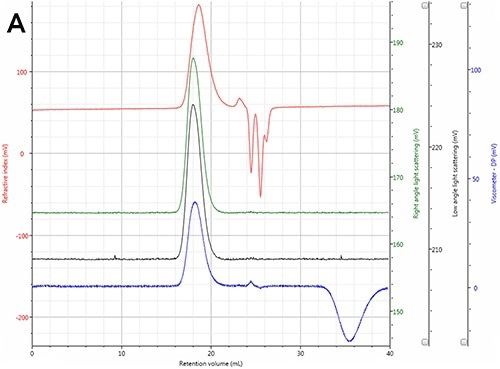
Figure 3. A. Chromatogram of a broad PMMA showing the RI (red), Viscometer (blue) RALS (green) and LALS (black) detector signals.
Table 1. Measured molecular weight, polydispersity and intrinsic viscosity.
| Parameter |
Polymethylmethacrylate |
| Mn (Da) |
431,670 |
| Mw (Da) |
894,430 |
| PD (Mw/Mn) |
2.072 |
| Intrinsic viscosity (dL/g) |
0.361 |
| Rhw (nm) |
7.647 |
A PVC sample was dissolved in the mobile phase and isolated on the system. Its chromatogram is shown in Figure 4A, and the molecular weight results are displayed in Table 2, with the absolute MW determined as 227kDa.
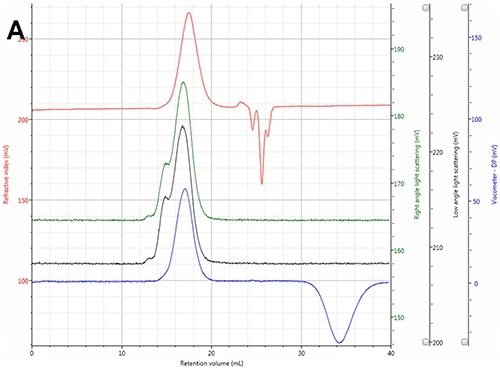
Figure 4. A. Chromatogram of polyvinylchloride (PVC) showing the RI (red), Viscometer (blue) RALS (green) and LALS (black) detector signals.
Table 2. Measured molecular weight, polydispersity and intrinsic viscosity.
| Parameter |
Polystyrene |
| Mn (Da) |
112,240 |
| Mw (Da) |
227,090 |
| PD (Mw/Mn) |
2.023 |
| Intrinsic viscosity (dL/g) |
1.353 |
| Rhw (nm) |
15.530 |
Figure 5 depicts a molecular weight distribution overlay of PVC (green), PMMA (purple), and polystyrene (red). On this graph, the plot signifies the weight fraction against molecular weight, and on the x-axis the molecular weight rises from left to right.
As illustrated by the polydispersity value (Mw/Mn), the peaks are polydisperse and indicate that the range of molecular weights within these peaks is wide.
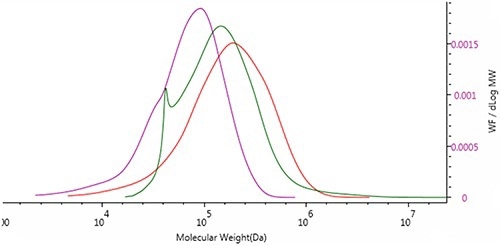
Figure 5. Molecular weight distribution overlay of polystyrene (red), PMMA (purple) and PVC (green).
Conclusion
This article shows the effective molecular weight measurement of a PVC, PMMA and polystyrene sample by means of the OMNISEC system. The system can precisely determine the absolute molecular weight of any polymers regardless of structure or elution volume. While the measurements were carried out using simple polymers, these techniques can be applied to any polymer determined by the GPC system.
Traditional chromatography solutions calibrated with molecular weight standards are not capable of precisely determining the samples’ molecular weights unless they had been calibrated using the suitable molecular weight standards for each type of sample.
Precise molecular weights can only be determined using a light scattering-based system such as OMNISEC. With this kind of precise data, polymer manufacturers can control their research, development and production process of the polymers.
This not only results in higher quality product and better grading but also reduces quality issues related to production. These enhancements in turn can lead to better product performance and increased company competitiveness.

This information has been sourced, reviewed and adapted from materials provided by Malvern Panalytical.
For more information on this source, please visit Malvern Panalytical.